
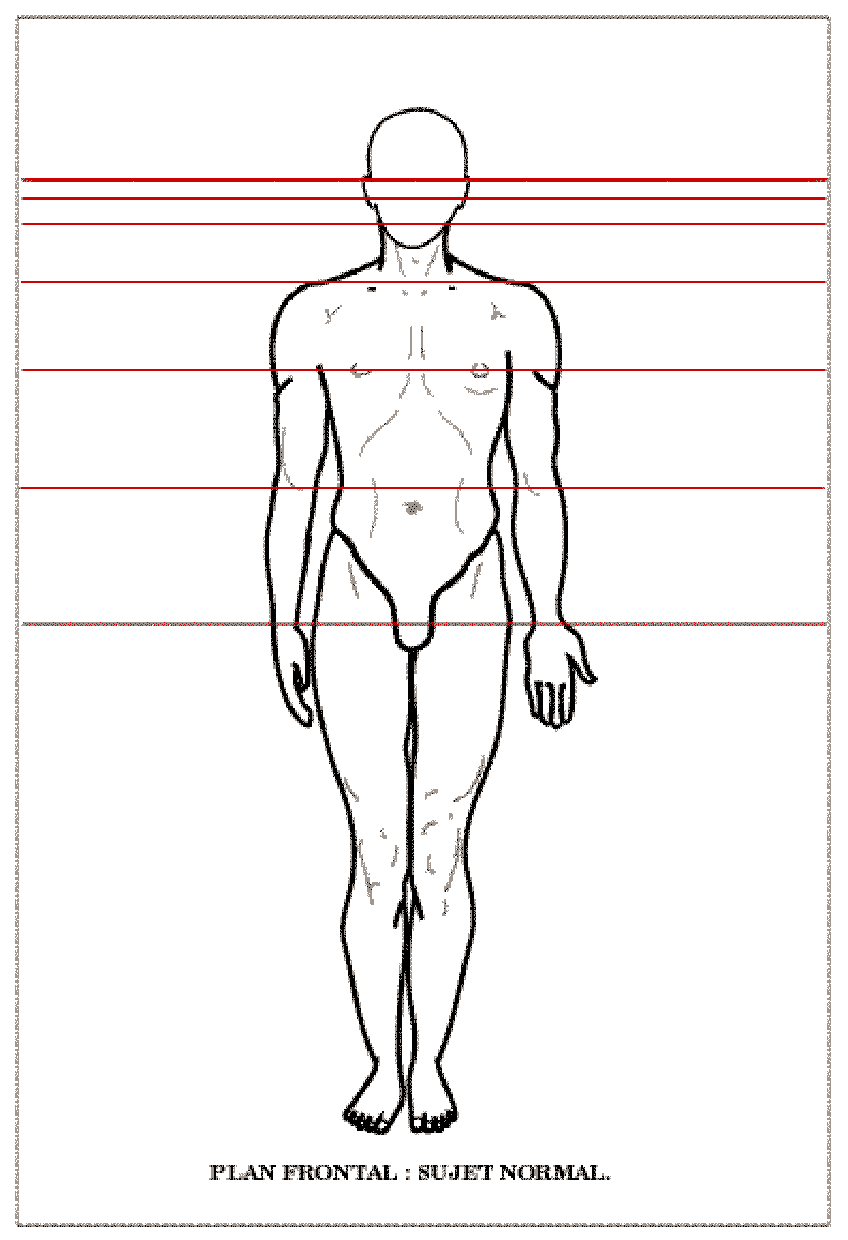
DEFINING STANDARDS IN CLINICAL POSTUROLOGY ?
Bertrand BRICOT
Researches made on posture since more than one hundred of years (Da Cunha, Paillard, Bricot, etc.) bring us to consider postural system as a whole, structured with several inputs and having several supplementary functions:
- Fighting against gravity to keep standing upright;
- Opposing outside forces;
- Finding our place in the space-time, which surrounds us;
- Keeping balance while moving, to drive and strengthen our movements
In order to realise this marvellous neurophysiological exploit, our body uses various information sources and structures:
- Exteroceptors, to set us in our environment (tact, vision, hearing);
- Proprioceptors, to set various parts of our body in relation with each other, in a given position;
- CNS Centres, to integrate data stemming from both previous sources and to select strategies or cognitive processes (Paillard).
And there is a " postural invariant ", which represents the “ideal” body position in space, at a given moment of our phylogenetic evolution.
I) NORMAL POSTURE
A) VIEW IN PROFILE (SAGITTAL PLANE).
The vertical axis of the body passes by:
- The vertex;
- Odontoid process;
- Body of the third lumbar vertebra;
- Centre of the support basis, at equal distance from both feet.
The scapular and gluteal planes are aligned.
Among adults the camber of lumbar vertebra should be from 4 to 6 cm (3 finger’s breadth);
The camber of cervical vertebra from 6 to 8 cm (4 finger’s breadth).


B) FRONT VIEW (FRONTAL PLANE).
Various lines should be horizontal:
- The bipupillary axis;
- The bitragal line;
- The bimamilla line;
- The line between both styloideus processes;
- The thoracic girdle;
- The pelvic girdle.
Some posturologists consider a light tilting of girdles as normal and physiological: we do not share this opinion because the correction of the postural system, such as we do it, often allows a complete correction of the tilting.
Our laterality, indeed, and our education push us to imbalance but we can not consider this phenomenon as normal. It is striking to notice how perfectly well balanced subjects never suffer from their back.
Feet rest on the ground in a harmonious and symmetric way, a light valgus connected to two feet support can be considered as physiological, it disappears during one-foot support.
C) THE HORIZONTAL PLANE
There is neither forward nor backward position of buttock and shoulder with regard to each other.
CONCLUSION.
So we define normal orthostatic posture. Only less than 10 % of the population seems to correspond to these criteria, these subjects almost never suffer from pains.
NORMAL POSTURE
=
ABSENCE OF CONSTRAINT, HARMONIOUS RELATIONSHIP
=
NO PAIN.
II) ABNORMAL POSTURE
More than 90 % of subjects present a postural imbalance.
A) VIEW IN PROFILE (SAGITTAL PLANE).
Four main parameters are to study:
1) The scapular plane;
2) The gluteal plane;
3) The cervical camber;
4) The lumbar camber.
Only the A occurrence is normal; four main static confusions:
- B, scapular and gluteal planes are aligned: with increase of cambers;
- C, posterior scapular plane.
- D, anterior scapular plane;
- E, scapular and gluteal planes aligned: with decrease of cambers.
- The distance between back plane and occiput should be lower than two finger’s breadth.
B) FRONT VIEW OF DISORDERS
Postural disorders will be noted more easily at the girdle level.
1) Tilting of shoulders:
In the absence of reference pattern or of complementary exams, this tilting is more easily studied at the level of wrists (styloide process).
2) Position of pelvis in space:
Only studying the position of pelvis in space from a medio-iliac point of view will give us some certainty.
It is not rare, indeed, to notice a difference between conventional marks, forward or backward, that results from a helical twisting of the pelvis on its main axis.
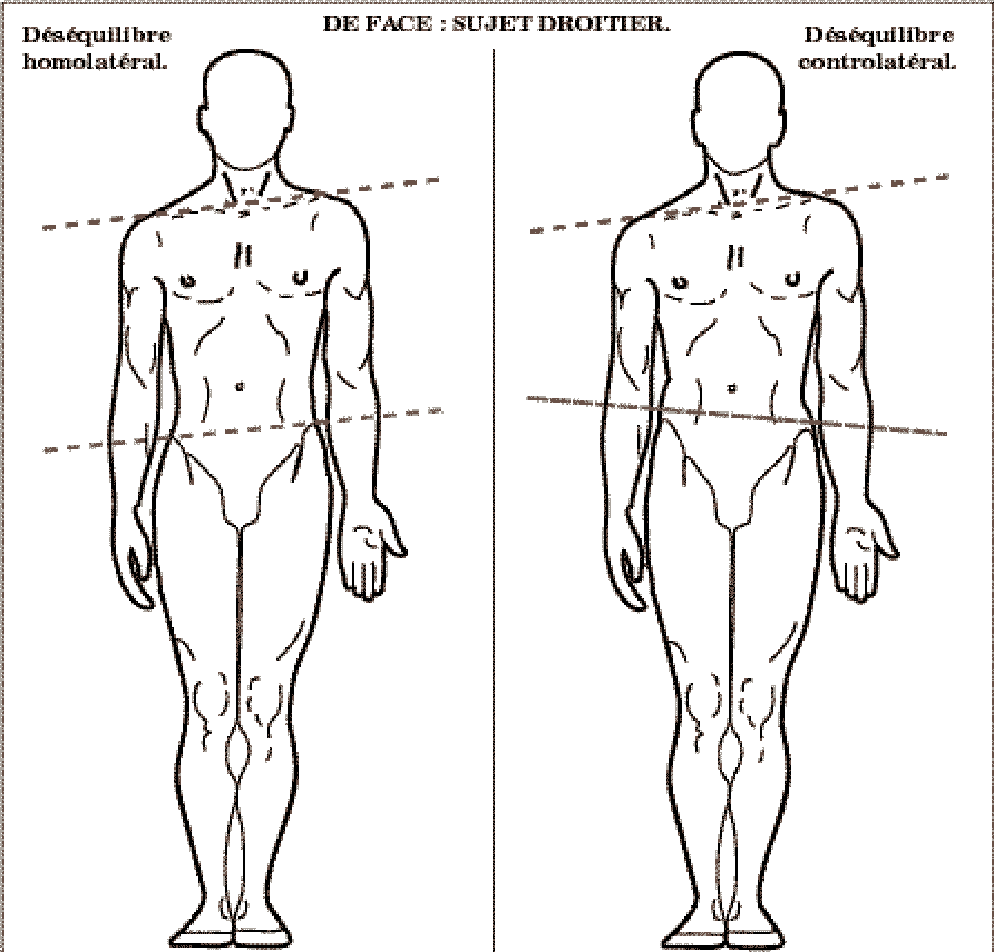
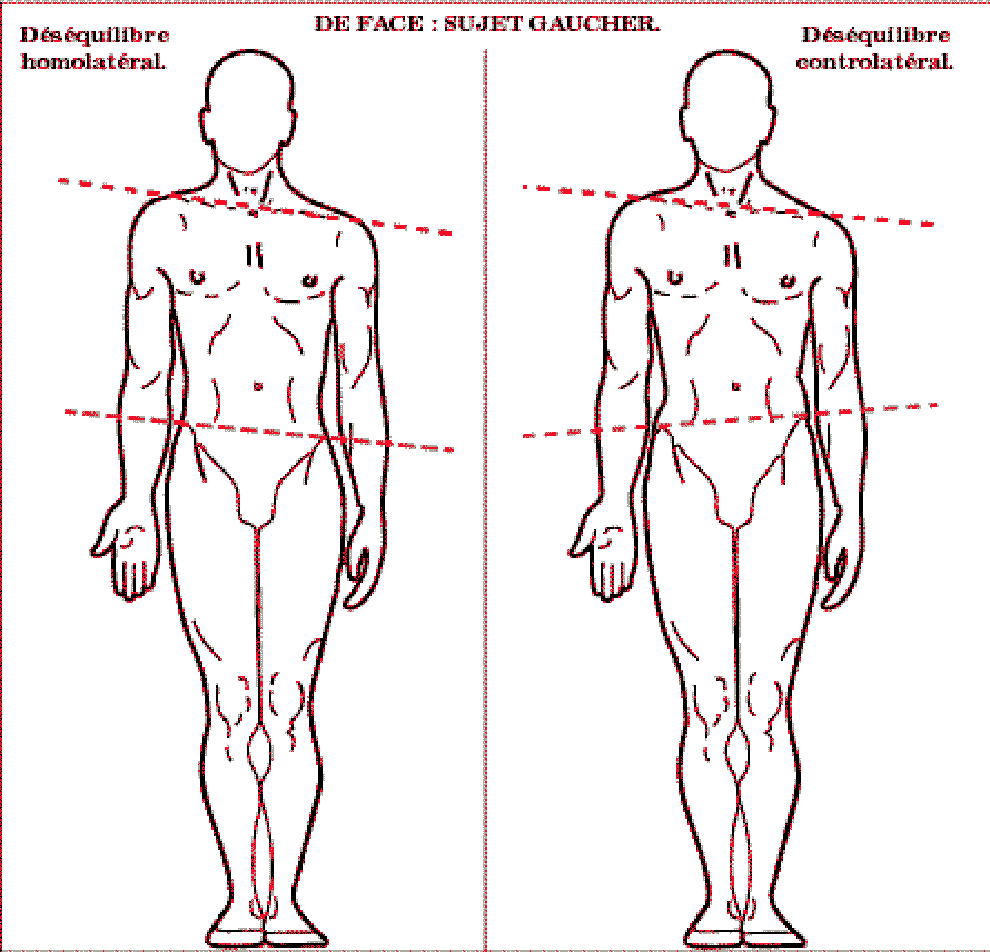
3) Three fundamental notions appear:
a) Imbalance of scapular girdle is connected to the laterality:
- Generally among right-hander, left shoulder is higher;
- Among left-hander, it is the reverse.
b) When shoulders and pelvis tilt in the same direction:
- Eyes are primary perturbed input;
- Feet are primary perturbed input when tilting of shoulders and pelvis are opposite.
c) There is always a neuromuscular deficit and micro-circulatory disorders in the upper limb on the side of the lowest shoulder (generally the laterality side).
C) STATIC DISORDERS IN THE HORIZONTAL PLANE.
It is the study of shoulders and pelvis rotations; one speaks then:
- Of forward or backward ilium;
- Of forward or backward scapulum.
Constraints then are in rotation and/or in twisting.
Rotation of the scapular girdle is strongly influenced by laterality.
As regards pelvis rotations they can be in the same direction as those of shoulders, or the other way.
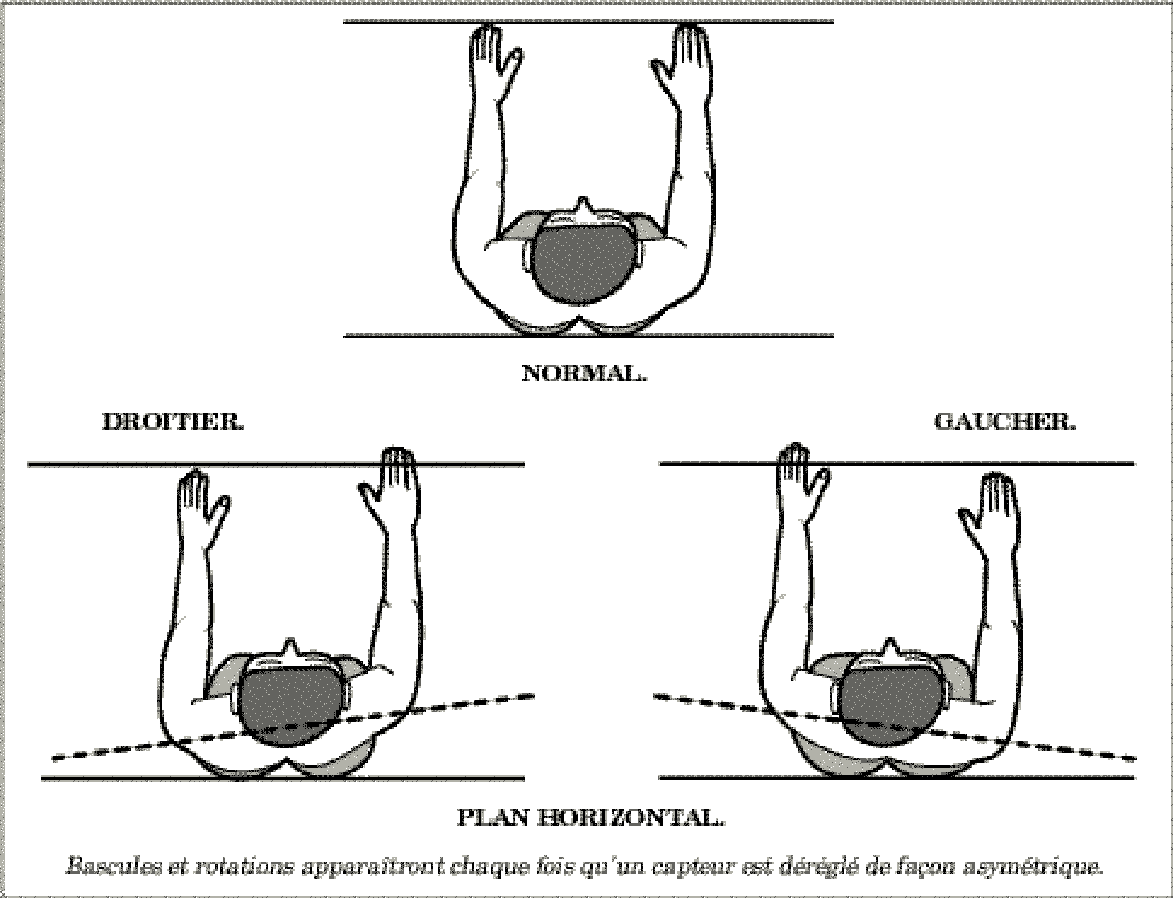
CONCLUSION.
So are defined the static disorders in three space planes. Most of the time these disorders are associated, and realise a more or less complex static syndrome, responsible for hyperconstraints of joints, ligaments and muscles of spine (Bricot, Auger, Bougros).
ON THE WHOLE:
It is difficult to consider subjects that present a postural clinical imbalance as normal subjects, for several reasons:
- The subjects having a posture clinically well balanced do not suffer from low backpain;
- The patients who are suffering always present an obvious postural imbalance;
- When postural system inputs are out of order that brings about postural imbalance, the body never cures itself, on the contrary it integrates the new postural scheme and considers it as normal;
- After about ten months of postural treatment, when the practitioner arrives at a complete correction of his patient postural imbalance, then, most of the time, pains have disappeared. The new balance is stable in time (at least if corrections are suppressed progressively).
If " the standards of stabilometric parameters made by the French Association of Posturology [NORMES 85] have the merit of being" (Gagey), they were established in a completely arbitrary way: subjects were considered as normal, because they did not suffer of any known disease or dizziness or low back pain, and they had no particular treatment.
In fact many researches made among pupils at school have shown that only 11 % of the children have no disorders of their postural system inputs (Barber, Aït-Abbas, Ceccaldi, Kohen Raz); what means that 89 % of children have one or several inputs disordered, already. Besides, if patients that suffer from pains, always have a postural imbalance, the reverse is not systematically true and a subject presenting a postural imbalance does not systematically suffer from pain.
In 1985 in Paris, Posturology was rather interested in balance disorders, as ENT and neurologists do, about dizziness and its minor equivalents essentially (even in 1992 in the book Les troubles de l’équilibre).
In everyday clinical practise, we meet an extremely frequent paradox: patients who are suffering in a chronic or acute way from various pains, often very important, are completely inside the limits of normality given by Normes85 (Bizzo). It is the same for some patients suffering from functional dizziness.
So logically, we thought it was necessary to verify on a standardised platform the stabilometric parameters of subjects, which we considered as normal clinically, that is to say without postural asymmetries in the three directions of the space and without disordered inputs.
We compared our results with the standards from Normes85.
POPULATION
Subjects were selected essentially among patients having finished their postural treatment (our ‘reprogrammation posturale’), these selected subjects did not suffer from pain or dizziness, generally, but they were especially well balanced according to our clinical examination.
This clinical examination is realised according to the standards of the International School of Study of Statics (C.I.E.S) to verify the symmetry of the body in the three space directions, as well as the good functioning of the main inputs of the postural system (according to the standards of the C.I.E.S too):
- Feet must be symmetric, with a light valgus on two feet, without on one foot, without rotatory pivot at the level of ankle joint;
- Eyes: with usual correction, corrective lenses well centred, binocular vision, convergence in the nose root, exo/esophoria less than 1 or 2 diopters, no hyperphoria;
- Occlusion balanced, class I;
- No pathological scars.
68 subjects were retained.
We did not put an age limit, the tested subjects had from 10 to 79 years, mean 43,3 years; 30 men and 38 women.
MATERIAL AND METHOD.
The study was realised on a standardised stabilometric platform (QFP system) according to the standard conditions of AFP.
Two recordings are made, over 51,2 seconds each, first Eyes Open (EO), then Eyes Closed (EC), sampling frequency 5 Hz.
Statistical analysis: parametric univariate t-test; summary tables of the descriptive statistics and study of centiles.
The analysed parameters are:
Area, length, X-mean, Y-mean, LFS, VFY, Romberg's quotient.
RESULTS.
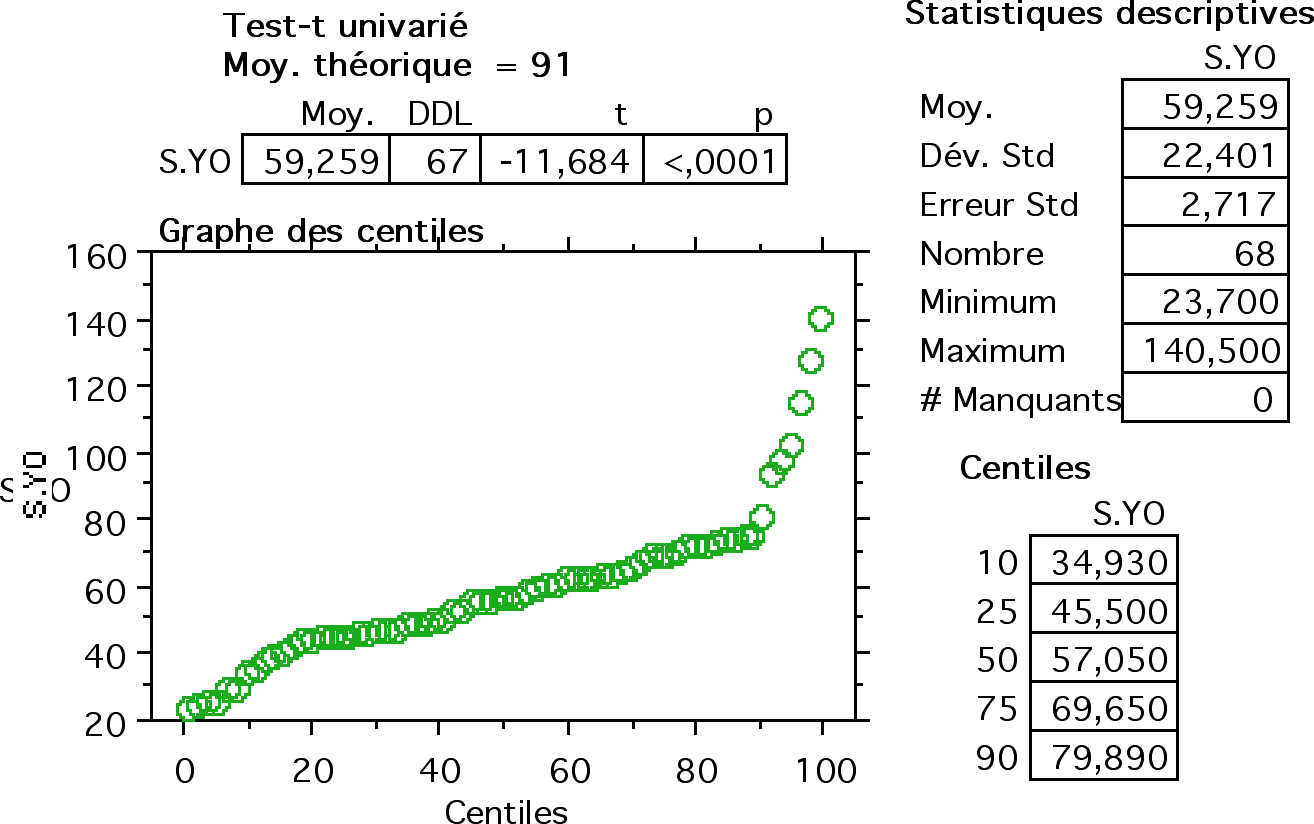







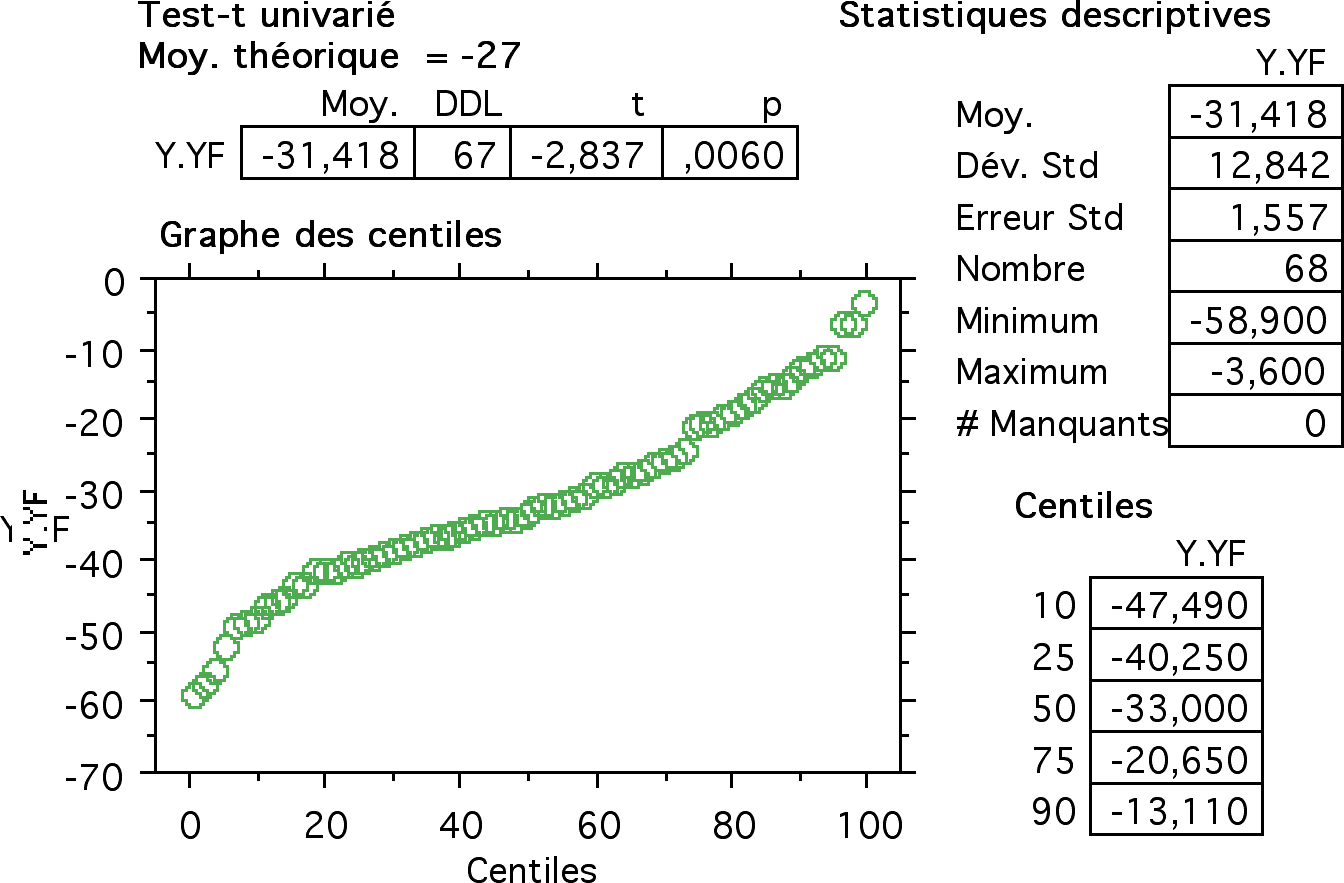


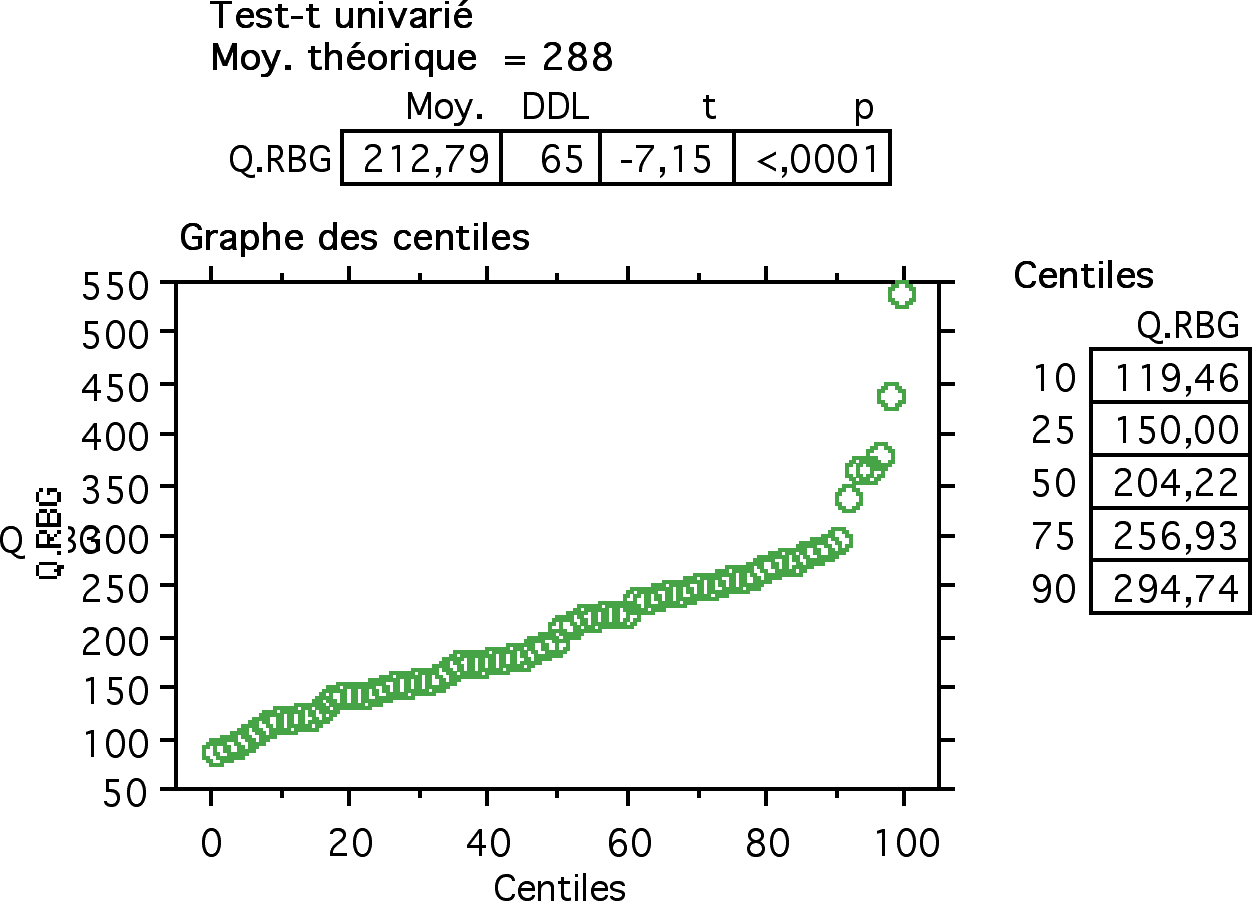
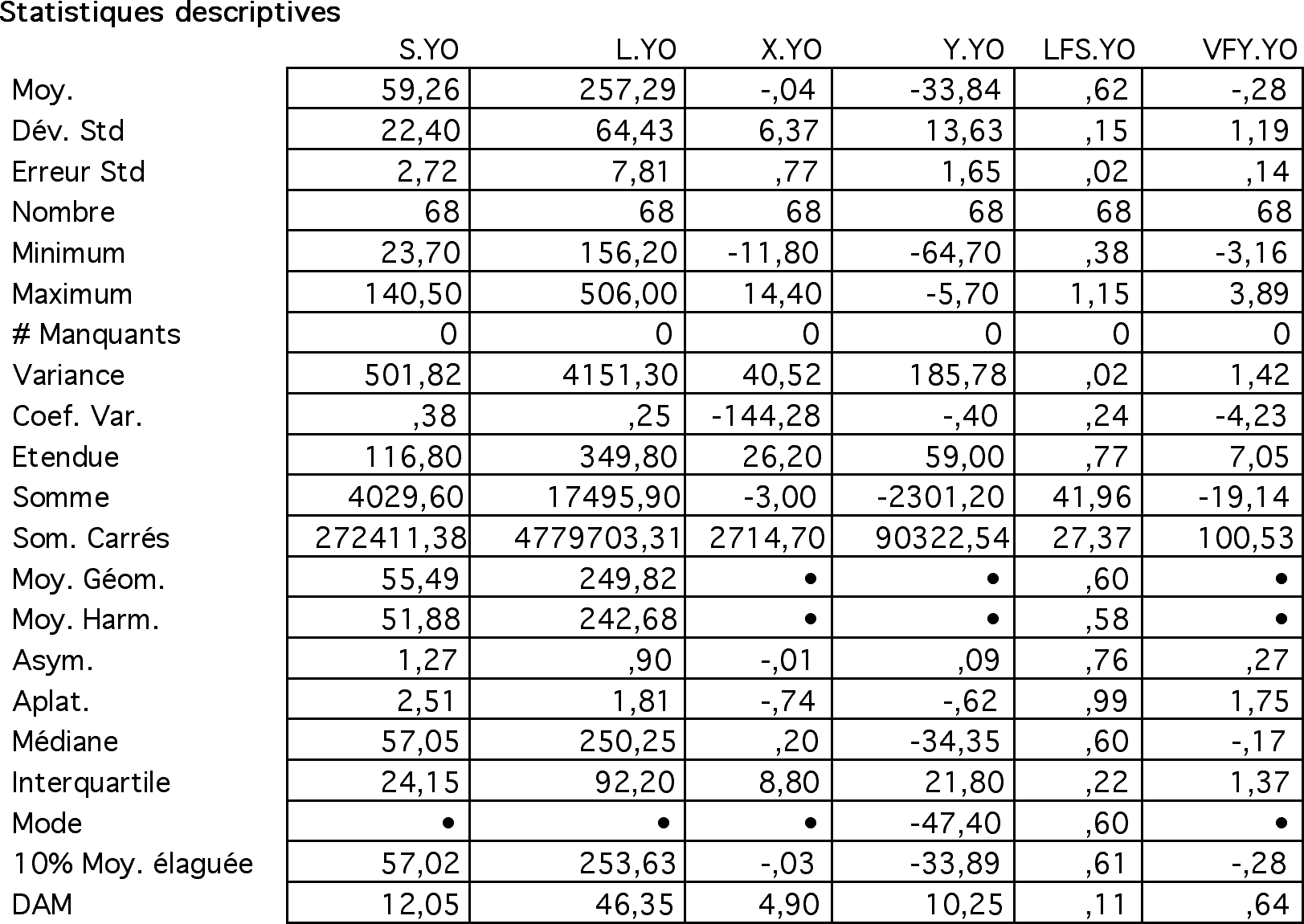
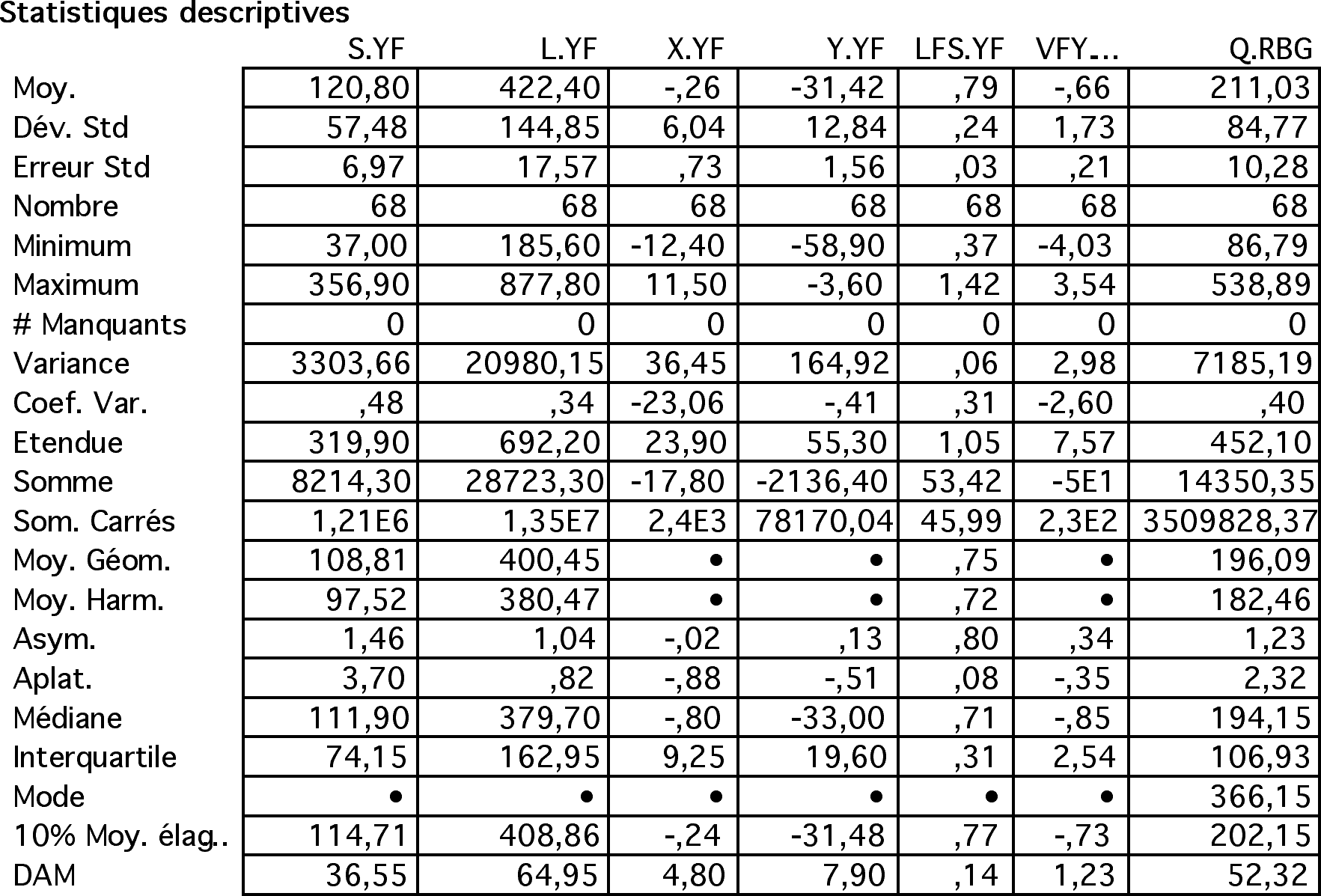
CONCLUSION:
Our confidence limits are much less tolerant than the ones of Normes85. It is rare to find a patient suffering from pain or dizziness inside these confidence limits. This study should be refined according to age classes and concern a more important number of patients.
The last remark is that it is necessary to consider as normality not the conventional mean but the harmonic mean.
BIBLIOGRAPHIE
AIT-ABBAS L. (1992) Occlusion et posture de l’enfant. Toulouse. Mémoire pour le Diplôme Universitaire d’Occlusodontologie
AUGE R. L’Ajustement proprioceptif chez les lombalgiques. Kinési. Scient. N° 122 19,30
BARBIER L. (1994) Posture et statique chez l’enfant. Étude statistique réalisée en milieu scolaire. Paris Archives du C.I.E.S. 367 av. du Prado Marseille 13008..
GAGEY P.M., ASSELAIN B., USHIO N., BARON J.B. (1977) Les asymétries de la posture orthostatique sont-elles aléatoires? Agressologie, 18, 277-283.
DUPONT Ph (1992) Les troubles de l’équilibre, Frison-Roche, Paris.
BIZZO G, GUILLET N, PATAT A, GAGEY P-M. (1985) Specifications for building a vertical force platform designed for clinical stabilometry. Med Biol eng et Comput. 474-476
BOUGROS. Compte rendu expérimentation sur les semelles polarisantes. Hôp Cavaillon Sce Chir Archives du C.I.E.S. 367 av. du Prado 13008 Marseille.
BRICOT B. (1981) Contribution à la correction des troubles du tonus postural par action sur l’appui podal. Marseille Thèse Médecine. .
BRICOT B. La reprogrammation posturale globale Sauramps Médical ISBN : 2 84023 110 7.
DA CUNHA H.M. (1987) Le syndrome de déficience posturale. Agressologie, 28, 941-943.
EUZET J.-P. (1987) Approche méthodologique de l’évaluation de l’équilibre postural. Nice Mémoire de maîtrise fondamentale - S.T.A.P.S./U.F.R.E.P.S..
GAGEY P-M, BIZZO G, BONNIER L, GENTAZ R, GUILLAUME P, MARUCCHI C. (1990) Huit leçons de Posturologie. Association française de posturologie..
KOHEN-RAZ (1986) Learning disabilities and postural control. Freund Publ. House, London.
PAILLARD J. (1980) Le corps situé et le corps identifié : une approche psychophysiologique de la notion du schéma corporel. Rev. Med. Suisse Romande 129,141.
VAN PARYS, NJOKIKTJIEN (1976) Ch. Romberg’s sign expressed as a quotient. Agressologie. 17, B. 95-100
COMMENTS
1) From Pierre-Marie GAGEY
This very nice work develops two aspects of clinical Posturology:
- The arbitrary aspect of "Standards" and
- The very strong link which exists between asymmetries of the orthostatic posture and pains from body axis.
On this last point exists a very strong consensus between all the posturologists; it is not possible to practise Posturology without noticing this evidence that pains of the body axis and the important asymmetries of orthostatic posture disappear together under the influence of the treatment. The interest of this work is to allow ‘not-posturologists’ to share our evidence by presenting a statistical study on this matter. Patients treated by posturological techniques are statistically " Better than Well " on stabilometric platforms, when they practically stopped suffering.
There is also a very strong consensus among statisticians to underline that establishing standards is somewhat arbitrary. This arbitrariness burst in broad daylight admirably when one begs the question by selecting a "Normal" sample of the general population to establish standards!… What would allow saying that this sample of population would be normal? Because it would be constituted by “practically” painless subjects? But what does 'practically’ want to say? Because it would be constituted by symmetric subjects? But absolutely no man is perfectly symmetric, what would be the asymmetries which one could tolerate for subjects inside a "Normal" sample of the general population?
So this work is particularly interesting because at the same time it asserts and it demonstrates that establishing standards has an arbitrary aspect, and consequently we must not try to have standards say more that they can do.
In this way, I take the sketch of the " Ideal Perfectly Symmetric Man"as the expression of an idea, not of reality, of course. This idea, which drives therapists making them look for symmetry in order to cure pains efficaciously.